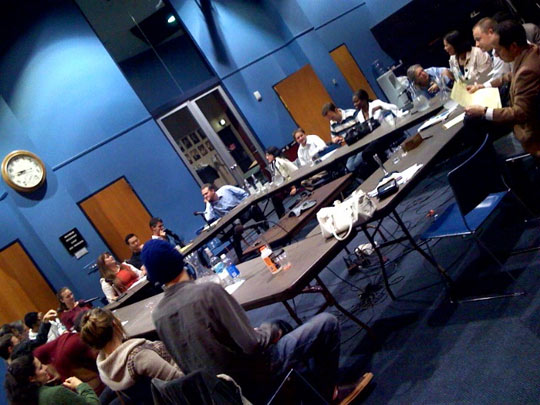
What to Expect...
|
SFdebate is different from your high school debate competitions. We operate more like a parliament or town hall discussion. There are no winners and no losers and our goal is to accomodate many points of view in a fun and informative discussion on topical affairs.
To prevent proceedings degenerating into a slanging match, we have a few simple rules. They exist to keep argument (more or less) civilised, they're not there to intimidate anyone! Structure Of The DebateDebates start with a motion, which takes the form 'This House Would...' or 'This House Believes...' or something similar. The debate is begun by the "table speakers" (thus named because they sit on each side of the table at the front of the room), who form two sides, the proposition and the opposition, each with a couple speakers. The debate is controlled by the chairman. The task of the proposition is to define the motion clearly, and then persuade you to vote in favour of it. For example, if the motion was 'This House Would legalize marijuana', they would need to tell the house exactly what they're going to legalize - just posession of small quantities, or medical marijuana, or perhaps open sale over the counter from 7-Eleven. Meanwhile, the task of the opposition is to tell us why the proposition is wrong. The opposition might offer you an alternative policy, or they might argue for the status quo. Table speakers usually have five minutes each in which to make their case, with each proposition speech followed by an opposition speech. Sometimes, if we have a really high-profile speaker, or if the debate is particularly explosive, we give the speakers up to seven minutes - but they'll still only get 2 minutes protected time. After the table speakers have had their say, the debate moves on to the most interesting bit, the floor speeches. Floor Speeches & DiscussionThis is where you get your say. At this point, anyone present in the audience ("on the floor") is welcome to make a speech, either in support of the motion, against it, or if you don't agree with what either side has said, you can speak in abstention too. For smaller, less well attended meetings, this part of the debate may evolve into an open discussion. Floor speeches are limited to a maximum of two minutes in length, but if you just want to say a few words and make a short point, it's fine to speak for only a few seconds. Floor speaking is the perfect arena in which to hone your public speaking skills and your ability to think on your feet, and each week a small prize is awarded to the best floor speaker. Speeches from the audience are what makes the debate, so go on, have a go! Points Of InformationChances are that at some point during the debate you'll be bubbling with indignation at what someone has said. Don't worry, outside the speaker's protected time you don't have to contain yourself, you can jump up and make a point of information. Stand up and exclaim 'Point of information!' or something similar. The speaker isn't obliged to listen to what you have to say, and may just tell you to sit down, but if they let you, you can ask a question or point out a fact that may have escaped the speaker's attention. POIs should be kept short - they're points, not speeches. 15 seconds is a real maximum. Points Of OrderThese are much more serious, and should be used with caution. A point of order is used when the rules and conventions of debating are being seriously broken. For example, if a speaker is being seriously offensive or rude to another speaker, a point of order might be raised. The chair decides what action, if any, should be taken. Summation Speeches And The VoteAfter the floor speeches are over, the debate returns to the table, for summation speeches lasting four minutes, one from each side. The opposition summate first, thus giving the proposition the final word in the debate. Summation speeches can't be interrupted by points of information. Finally, the crucial part of the debate is the vote. Voting is done by a show of hands, and you may vote for any one of proposition, opposition or abstention. If the proposition gets the most votes, the motion is carried, and if the opposition gets the most votes, the motion falls. Abstention votes can't win - they are effectively meaningless - they're just a protest vote. Socializing & Drunken DebateAfter the vote has been announced and the floor speech prize awarded, proceedings move on to a nearby bar, where increasingly incoherent debate and socialising may continue. |
Join Our Group!The SFDebate group connects and updates members on events through Meetup.com - If you've not yet joined the group, here's the link. SFDebate Meetup Group |
